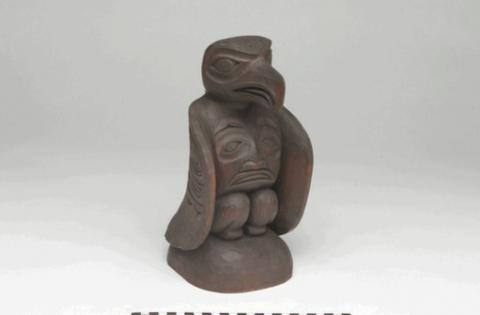Eagle Totem
Amos carved this piece from yellow cedar and painted it a dark color. Normally yellow cedar has a bright yellowish color that it tends to keep if not placed outside. Small figures like this were usually carved as a commissioned piece for non-traditional use. At 29.8cm or 11.6 inches tall this is somewhat smaller than most commissioned pieces from local people. This piece was probably made for the public market. Amos carved this piece in 1962 while working for the Indian Arts and Crafts Board (IACB) doing art demonstrations.
Yellow Cedar is an outstanding wood to carve, it cuts easily and cleanly, tends not to dull the knives as fast as other woods, does not rot as easily as other woods, it will take detail, and has a nice color and smell.
Yellow Cedar is an outstanding wood to carve, it cuts easily and cleanly, tends not to dull the knives as fast as other woods, does not rot as easily as other woods, it will take detail, and has a nice color and smell.
The Eagle is one of two moieties that make up the Tlingit nation. All Tlingit belong either the Raven or Eagle moiety and traditionally they could only marry the opposite moiety. Tlingit society follows a matrilineal family structure, you are the same clan as your mother.
Xáay (Yellow Cedar)
Naa (clans)
Yeil (Raven)
Ch’áak’ (Eagle)
Xáay (Yellow Cedar)
In the past Tlingits believe that all things have a life force and when carving, artists would depict the life force as a face and incorporate it into the design. On this piece, Amos chose to place that concept on the chest of the Eagle.
Figurine, eagle effigy, of carved yellow cedar stained dark brown, perching on wooden base with image of face on breast, and eye
imagery on wings and tail. Made by Amos L. Wallace while employed as a Demonstration-Aide at the 1961-1962 IACB Demonstration
Workshop in Juneau, AK.
Acquired by Indian Arts and Crafts Board representatives in 1962 when the artist was employed during IACB arts and crafts
demonstrations at Juneau, Alaska; part of the IACB Headquarters collection (Department of the Interior, Washington, DC) until 2000
when it was transferred to NMAI.

